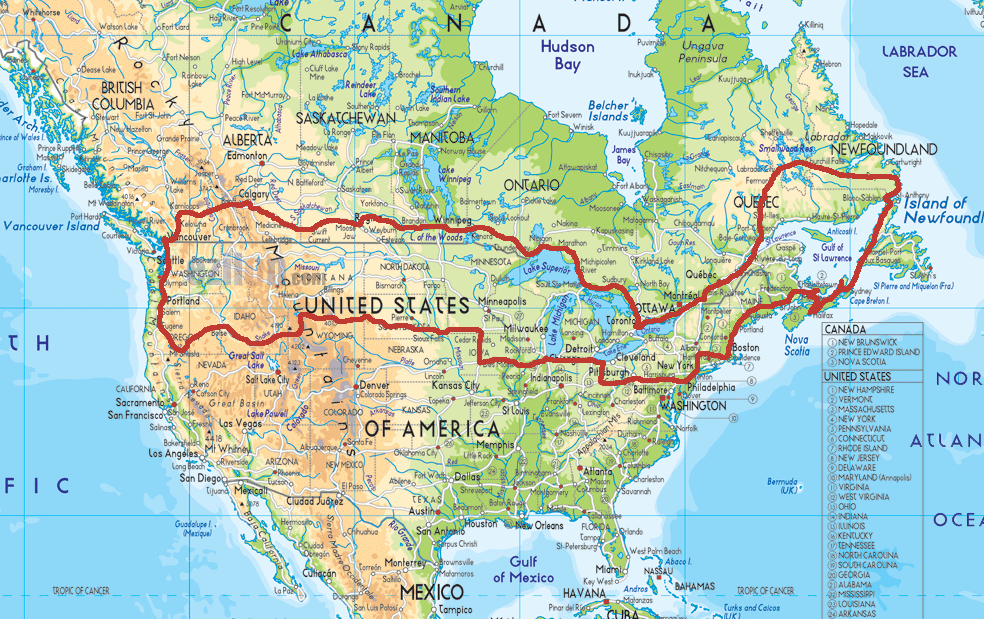North America is a sprawling continent, rich in natural beauty, cultural diversity, and economic opportunity. Among its many features, the vast network of highways serves as vital arteries for trade, travel, and communication. Have you ever pondered how transformative a highway map can be for a region, or considered the implications of our extensive highway system on the environment?
Highway maps are crucial for navigating the multifaceted landscape of North America’s transportation infrastructure. These maps often reveal connections between urban centers, rural communities, and national parks, providing insights into how we traverse this expansive territory. With major routes like Interstate 5 in the Western United States and Highway 401 in Canada, travelers can easily plan their journeys, optimizing time and efficiency.
Moreover, the emergence of digital mapping technology has revolutionized the way people access and utilize highway maps. Applications like Google Maps and Waze have made navigating these highways an almost seamless experience. But does this convenience come at a cost? With increasing reliance on digital tools, what happens to traditional navigation skills?
As one studies a physical highway map of North America, one immediately marvels at the intricate web of roadways weaving through mountains, valleys, and urban centers alike. The map’s cartographic representation not only guides the traveler but also serves as a historical testament to human engineering and ingenuity. The symbolism of these highways is profound, representing progress and connectivity. Yet, is this progress sustainable?
The extensive highway systems are undeniably beneficial for economic development, facilitating the movement of goods and services. For example, trucks transport approximately 71% of freight in the U.S. alone, underscoring the dependence on highways for the nation’s supply chain. However, this reliance poses significant challenges in the face of climate change. The emissions generated by vehicles contribute to air pollution and global warming, exacerbating environmental issues.
In the context of climate change, it is essential to evaluate the footprint of our transportation choices. The highways, while instrumental for connectivity, often become symbols of ecological disruption. Have you ever considered how many natural habitats have been altered or destroyed to pave the way for asphalt roads? The construction of highways leads to habitat fragmentation, affecting countless species and ecosystems across North America.
Furthermore, the increase in road development has led to urban sprawl, a phenomenon characterized by the uncontrolled expansion of urban areas. This not only strains infrastructure but also leads to loss of green spaces, increased greenhouse gas emissions, and ultimately, a decline in the quality of life for many residents. As communities expand into previously untouched territories, we face a growing challenge: how to balance development with environmental stewardship.
Innovations in sustainable transportation solutions are emerging as a means to mitigate these challenges. For instance, there is a growing emphasis on developing electric and hybrid vehicles, as well as promoting public transportation systems that reduce reliance on personal vehicles. However, does the mere introduction of such alternatives suffice to reverse the damage done? The question remains whether these innovations can outpace the historical growth of highway systems.
Moreover, integrating pedestrian and cycling infrastructure into existing highway frameworks is crucial. Bike lanes and pedestrian paths can encourage healthier transportation choices and reduce vehicle congestion. Cities like Portland, Oregon, and Montreal, Canada, have pioneered initiatives to promote alternative modes of travel, which subsequently help in reducing the overall environmental impact of transportation.
There is also a burgeoning movement advocating for ecologically sustainable highway design. This includes incorporating wildlife corridors into new highway constructions, allowing animals to cross safely and maintaining ecological connectivity. The reality of building highways that harmonize with nature presents a unique challenge to engineers and planners alike. How can we build networks that not only serve human needs but also protect the environment?
Furthermore, state and local governments are being called to action to reevaluate transportation funding and prioritize projects that align with sustainability goals. Efforts like the Green Infrastructure initiative focus on incorporating green spaces along highways and augmenting the climate resilience of urban areas. However, is enough being done? Are policymakers genuinely willing to sacrifice short-term economic gains for long-term environmental health?
As the conversation surrounding climate change intensifies, the importance of reevaluating our highway system’s future becomes increasingly pressing. The interplay between transportation, urban development, and ecological integrity highlights a narrative that demands our collective attention. Are we prepared to rethink our relationship with highways, or will we continue to prioritize convenience over sustainability?
In conclusion, while North America’s highway map serves as a testament to human ingenuity and connectivity, it simultaneously poses significant challenges that we must confront. The impact on the environment cannot be ignored. By integrating innovation and sustainability into our transportation planning, we can begin to reshape our highways for a more eco-friendly future. The question remains: Are we ready to reimagine these roads, not just as paths to our destinations, but as corridors of coexistence that promote harmony between nature and human activity?
